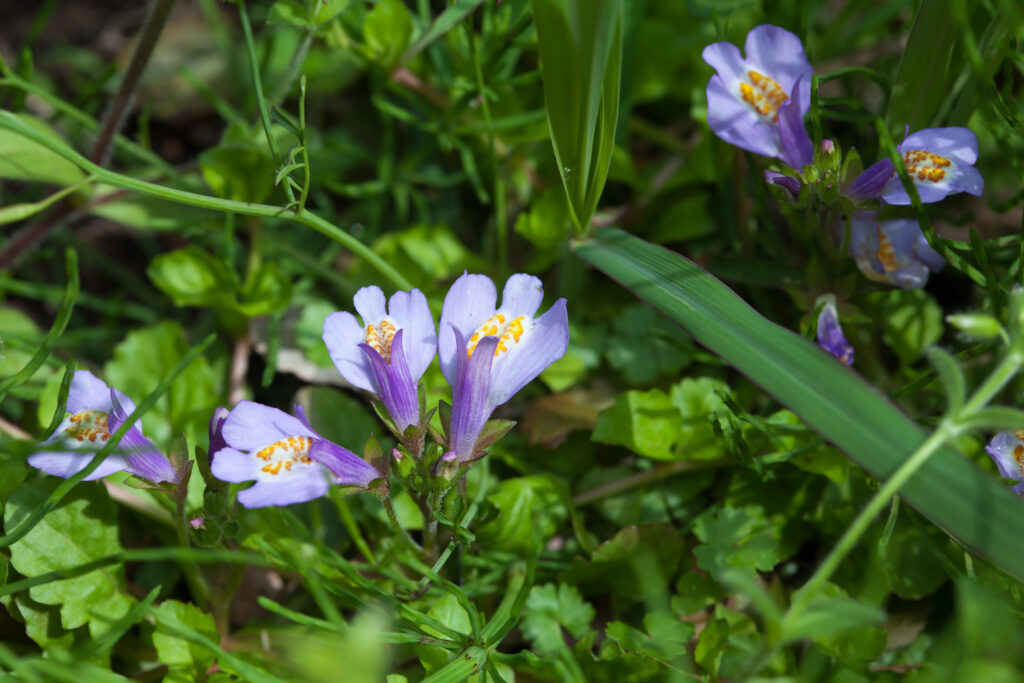Mazus (Mazus reptans) is a low-growing, fast-spreading perennial ground cover that belongs to the Phrymaceae family. Native to the Himalayas and parts of Asia, it’s popular in gardens due to its ability to form a dense mat of foliage and its attractive flowers. It typically reaches only about 2 inches in height, but it can spread quickly to cover large areas.
Mazus are typically low-growing, herbaceous plants with small, brightly colored flowers. Mazus plants are often used as ground covers in gardens and landscapes due to their spreading habit and attractive blooms. They prefer moist, well-drained soil and can tolerate partial shade. Mazus plants are relatively easy to care for and are a popular choice for adding color and texture to rock gardens, borders, and other areas of the garden.
Mazus description
- Foliage: Mazus has small, rounded, or oval-shaped green leaves that create a lush carpet. The foliage remains semi-evergreen in mild climates.
- Flowers: In late spring to early summer, Mazus produces small, tubular flowers that range from blue to violet, with white and yellow accents. The flowers add a lovely pop of color to the garden.
- Habitat: Mazus thrives in moist, well-drained soils and prefers partial to full sun. However, it can tolerate some shade, making it a versatile ground cover.
How to use Mazus in the garden
Mazus is both ornamental and functional, making it a versatile addition to many garden types.
- Ground Cover: Mazus is ideal for use as a ground cover in areas where you want low-maintenance greenery. Its dense mat of foliage helps suppress weeds and is perfect for filling gaps between pavers or stones in pathways.
- Lawn Substitute: It can be used as a low-growing, soft alternative to traditional grass in small, lightly trafficked areas.
- Rock Gardens: Mazus’s low-growing nature and tolerance of various conditions make it a great choice for rock gardens or sloped areas where erosion control is needed.
- Borders and Edges: Use mazus along garden beds, borders, or even as a soft edging plant around patios and pathways.
- Container Gardens: Although it’s more common in garden beds, mazus can also be used as a trailing plant in containers, adding lush greenery and small flowers to your pots.

Where to plant Mazus
- Mazus plants prefer full sun to partial shade. They will tolerate some shade, but may not flower as profusely.
- Mazus thrives in full sun to partial shade and well-drained soil. Choose a spot in your garden that receives at least 6 hours of sunlight per day. 2. Soil: Mazus prefers moist, fertile soil with a slightly acidic to neutral pH. Amend your soil with organic matter like compost or peat moss to improve drainage and fertility.
When to plant Mazus
- Mazus can be planted in spring or fall in well-drained soil that is rich in organic matter. Choose a sunny or partially shaded location for planting.et outdoors
Planting and spacing Mazus
- Plant in well-draining soil that is rich in organic matter. Space plants about 6 to 12 inches apart to allow room for spreading.
- Mazus can tolerate a variety of soil types, but loamy soil enriched with organic matter is ideal.
- Dig a hole slightly larger than the plant’s root ball and place it in the hole, covering the roots with soil.
How to water and feed Mazus
- Keep the soil evenly moist, but not waterlogged. Water mazus regularly, especially during hot, dry periods.
- Water deeply when the top inch of soil feels dry to the touch.
- Fertilize Mazus in the spring with a balanced, slow-release fertilizer. Avoid heavy fertilization, as this can lead to leggy growth and fewer flowers. Follow the instructions on the fertilizer package for application rates.
Mazus care
- Apply a layer of mulch around mazus plants to help retain moisture and suppress weeds. Organic mulch like bark chips or compost works well.
- Pruning: Trim back mazus plants after they finish blooming to encourage bushier growth and more flowers. Trim back any dead or leggy growth to encourage bushier, more compact growth.
Mazus pests and diseases
- Mazus is relatively resistant to pests and diseases, but keep an eye out for slugs, snails, and fungal infections. Remove any affected foliage and treat with an appropriate pesticide or fungicide if necessary.
Mazus propagation
- Mazus can be propagated by division or by taking stem cuttings in the spring.
- Mazus spreads via runners, and you can easily propagate it by dividing mature clumps in early spring or fall.Ensure the divisions have both roots and shoots before replanting in a new location.
Overall, mazus is a relatively low-maintenance plant that can provide a vibrant splash of color in your garden. With proper care and attention, it will thrive and spread to create a beautiful ground cover.
Mazus is a low-growing perennial plant that produces dainty purple, pink, or white flowers in the spring and summer. Mazus are often used as ground cover in gardens and are prized for their ability to tolerate a wide range of soil conditions and climates. Mazus plants are easy to grow and require minimal maintenance, making them a popular choice for gardeners looking to add some color and texture to their landscaping.



